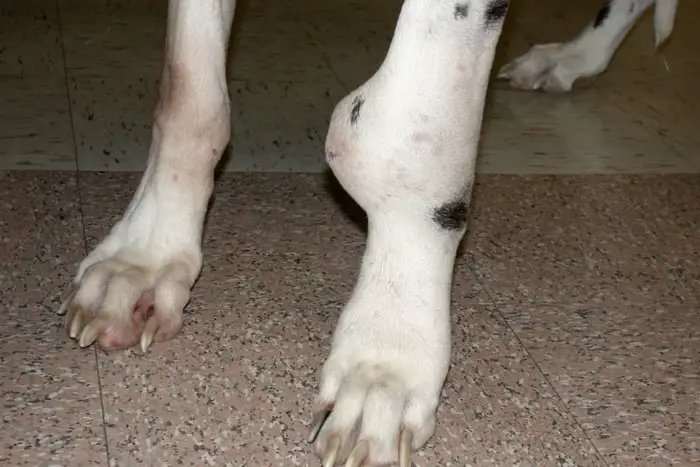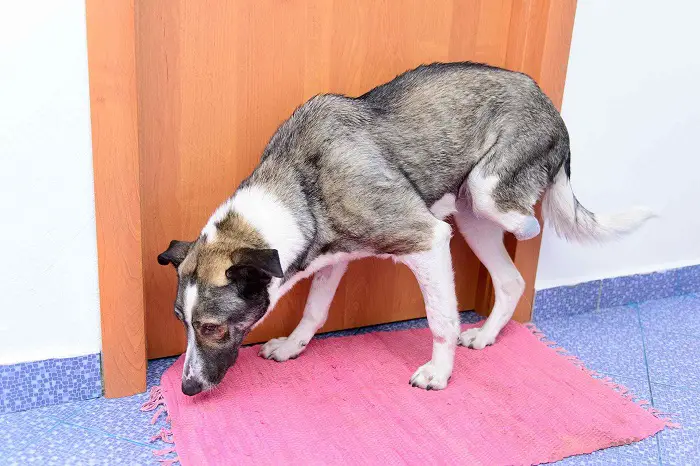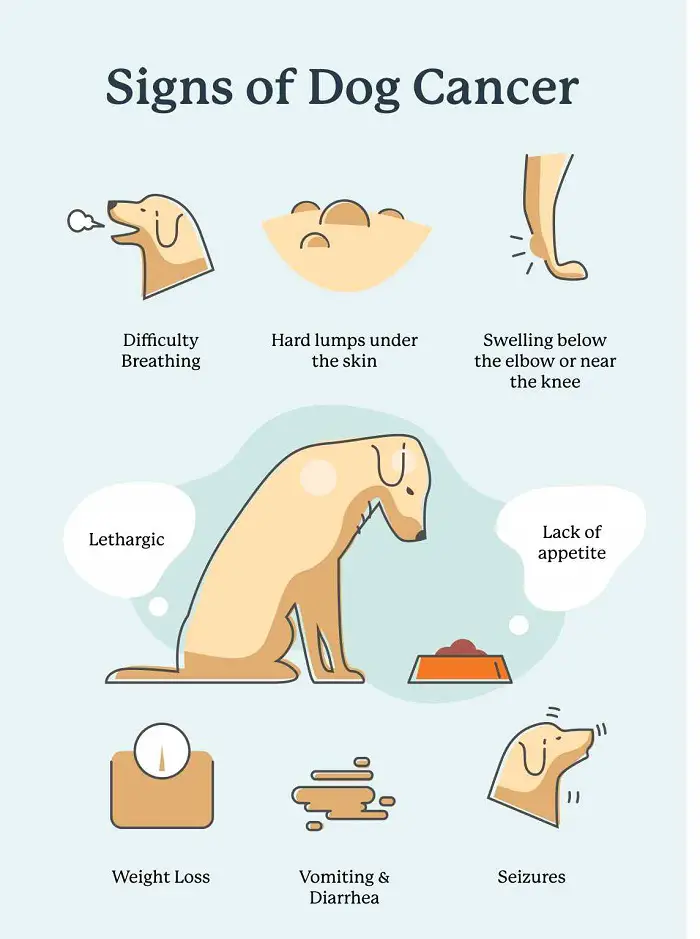Cancer in dogs, also known as canine cancer, mentions to the abnormal growth of cells in a dog’s body. Like humans, dogs can develop different types of cancer, affecting different organs and tissues. Cancer occurs when normal cells undergo genetic mutations that cause them to multiply and divide at an uncontrolled rate, forming a mass of cells called a tumor. These tumors can be non-cancerous (benign) or cancerous (malignant).
Causes of Cancer in Dogs
The exact causes of cancer in dogs are not fully understood. However, like humans, canine cancer is thought to be caused by genetic and environmental factors. Here are some factors that may contribute to the development of cancer in dogs:
- Genetic Predisposition: Certain dog breeds have a higher risk of developing specific types of cancer. For example, large and giant breeds are more prone to developing bone cancer (osteosarcoma), while Boxers have an increased risk of mast cell tumors. Genetic factors can influence susceptibility to cancer and the way tumors behave.
- Environmental Factors: Exposure to certain environmental factors can increase the risk of cancer in dogs. These may include second-hand smoke, pesticides, herbicides, industrial chemicals, and other environmental toxins. Dogs that live in areas with high pollution levels or are exposed to carcinogens may have an elevated risk.
- Age: The risk of developing cancer in dogs increases with age. Older dogs are more likely to grow tumors compared to younger ones. However, cancer can occur in dogs of any age.
- Hormonal Factors: Hormonal imbalances, such as those seen in unspayed female dogs (intact), can contribute to the development of certain cancers, including mammary gland tumors.
- Viruses: Some viral infections can increase the risk of cancer in dogs. For example, canine papillomavirus is associated with the growth of squamous cell carcinoma, a type of skin cancer.
- Obesity: Overweight or obese dogs may have a higher risk of growing different types of cancer, such as mammary gland tumors and bladder cancer.
Types of Cancer in Dogs
Various types of cancer can affect dogs. Here are some of the most common types:
- Lymphoma: Lymphoma in dogs, or lymphosarcoma, is a lymphatic cancer. It often affects the lymph nodes but can also involve organs such as the spleen, liver, and bone marrow.
- Mast Cell Tumors: Mast cell tumors originate from mast cells, immune cells throughout the body. These tumors can occur in the skin or internal organs and vary in aggressiveness.
- Osteosarcoma: Osteosarcoma in dogs is a type of bone cancer that usually affects the long bones, such as those in the limbs. It is commonly seen in large and giant dog breeds and tends to be aggressive.
- Hemangiosarcoma: Hemangiosarcoma is a cancer that originates from the cells lining the blood vessels. It commonly affects the spleen, liver, and heart and is known for its aggressive nature and tendency to cause internal bleeding.
- Melanoma in Dogs: Melanoma is a cancer that develops from pigment-producing cells called melanocytes. It can occur in the skin, eyes, or mucous membranes. Oral melanoma is prevalent in dogs.
- Mammary Gland Tumors: Similar to breast cancer in humans, mammary gland tumors can occur in female dogs. These tumors can be benign or malignant and are more common in unspayed female dogs.
- Squamous Cell Carcinoma: Squamous cell carcinoma primarily affects the skin and mucous membranes. It often occurs in areas with little hair or pigmentation, such as the ears, nose, lips, and genitalia.
- Transitional Cell Carcinoma: Transitional cell carcinoma usually affects the urinary bladder and urethra. It is more common in certain breeds and can cause clinical manifestations such as blood in the urine, frequent urination, and difficulty urinating.
- Soft Tissue Sarcoma: Soft tissue sarcomas in dogs are a group of cancers originating from connective tissues such as muscles, fat, or blood vessels. They can occur anywhere in the body and vary in behavior and aggressiveness.
These are just a few examples of the many types of cancer that can affect dogs. Each type of cancer may require different diagnostic tests, treatment approaches, and prognoses. If you suspect your dog may have cancer, it is essential to consult with a veterinarian for a proper diagnosis and treatment plan.
What are Cancer Signs in Dogs?
The signs and symptoms of neoplasia in dogs can differ depending on the type of cancer and its location in the body. Here are some common signs that may indicate the presence of cancer in dogs:
- Lumps or Bumps: Any unusual growths or swellings on or beneath the skin should be investigated. These may vary in size, shape, and texture.
- Abnormal Odors: Foul or persistent odors emanating from any body part, including the mouth, ears, or skin, can be a sign of cancer.
- Abnormal Bleeding: Unexplained bleeding or discharge from any body opening, such as the nose, mouth, ears, or genital area, can indicate a potential issue.
- Weight Loss: Significant and unexplained weight loss is a common symptom of many types of dog cancer.
- Loss of Appetite: A sudden decrease in appetite or refusal to eat can indicate an underlying health issue, including cancer.
- Lethargy and Weakness: Dogs with cancer may exhibit increased fatigue, lack of energy, and decreased stamina. They may seem less interested in activities they used to enjoy.
- Changes in Behavior: Dogs with cancer may display changes in behavior, such as increased irritability, aggression, or withdrawal.
- Difficulty Breathing: Cancer affecting the respiratory system can cause difficulty breathing, coughing, or wheezing.
- Lameness or difficulty Moving: Bone cancer or tumors near the joints can cause lameness, limping, or difficulty in movement.
- Digestive Issues: Cancer affecting the digestive system can cause vomiting, diarrhea, constipation, or difficulty swallowing.
Diagnosis of Cancer in Dogs
Diagnosis of cancer in dogs typically involves a combination of methods to determine the disease’s presence, type, and extent. Here are some common diagnostic approaches used by veterinarians:
- Physical Examination: A thorough physical examination allows the veterinarian to assess the dog’s overall health, examine any lumps or abnormalities, and identify potential signs of cancer.
- Medical History and Symptoms: Gathering information about the dog’s medical history and any symptoms or changes observed by the owner helps provide valuable clues and aids in the diagnostic process.
- Laboratory Tests: Blood tests, urine tests, and other laboratory analyses can provide important information about organ function, blood cell measurement, and the presence of specific substances that may suggest cancer.
- Imaging Techniques: Various radiological imaging techniques are used to visualize the internal structures of the dog’s body and detect any abnormalities. These may include X-rays, ultrasounds, CT scans, or MRIs. Imaging helps identify the location and size of tumors and any potential metastasis (spread) of cancer.
- Biopsy: A biopsy involves the collection of a small sample of tissue from a suspicious area, which is then examined under a microscope by a veterinary pathologist. Biopsies help determine the type of cancer and its aggressiveness and guide treatment decisions.
- Cytology involves microscopic examination of cells obtained from fluid or fine-needle aspirates of lumps or masses. It can provide valuable information about the nature of the cells, whether they are cancerous or benign.
- Histopathology: In some cases, a more extensive surgical biopsy or tumor removal is required. The tissue sample is sent to a veterinary pathologist, who examines it under a microscope to provide a definitive diagnosis.
Differential Diagnosis of Neoplasia in Dogs
When evaluating a dog with suspected neoplasia (abnormal growth or tumor), veterinarians consider a range of differential diagnoses, which are other potential conditions with similar clinical signs. It’s important to rule out these other conditions before confirming a cancer diagnosis. Here are some common differential diagnoses for neoplasia in dogs:
- Inflammatory Conditions: Inflammation in various organs or tissues can cause similar symptoms to neoplasia. Conditions like infections, abscesses, and immune-mediated diseases may mimic the appearance of tumors.
- Benign Tumors: Not all tumors are cancerous. Some tumors, such as lipomas (benign fatty tumors) or papillomas (wart-like growths), may resemble malignant tumors but are not invasive or metastatic.
- Infections: Certain infections, such as bacterial or fungal infections, can cause the formation of nodules or masses that may mimic tumor growth.
- Cysts in Dogs: Cysts are fluid-filled sacs that can develop in different tissues. They often appear as lumps or bumps and may be mistaken for tumors. Common types include sebaceous cysts, dermoid cysts, or ovarian cysts.
- Hematomas: Hematomas are blood collections that can form under the skin or within organs. They can mimic tumors in their appearance and may be caused by trauma or other underlying conditions.
- Granulomas: Granulomas are inflammatory nodules formed in response to infections, foreign bodies, or immune-mediated processes. They can appear similar to certain types of tumors.
- Hyperplasia: Hyperplasia refers to the excessive growth of cells in an organ or tissue. It can remarkably mimic the appearance of neoplasia when cells are increasing rapidly.
- Trauma: Traumatic injuries, such as hematomas or hemangiosarcomas caused by blunt force trauma, can be mistaken for tumors.
- Other Systemic Diseases: Some systemic diseases, such as certain endocrine disorders or autoimmune conditions, can present with tumor-like masses or abnormalities.
To arrive at a definitive diagnosis, veterinarians utilize diagnostic tools such as physical examination, laboratory tests, imaging techniques, and biopsies to differentiate between neoplastic and non-neoplastic conditions.
Treatment of Cancer in Dogs
Cancer treatment in dogs depends on various factors, including the type of cancer, its stage, the dog’s overall health, and the available treatment options. The primary goals of cancer treatment in dogs are to control the disease, alleviate symptoms, and improve the dog’s quality of life. Here are some common treatment modalities used for canine cancer:
- Surgery: Surgery involves the removal of the tumor and surrounding tissues. It is often the treatment of choice for localized tumors that have not spread. Surgery can cure some cases or help alleviate symptoms and improve the dog’s prognosis.
- Chemotherapy involves using chemicals to kill cancer cells or slow down their growth. It is commonly used in dogs with cancers with a high risk of spreading or cannot be entirely removed by surgery. Chemotherapy can be given orally or intravenously, and treatment protocols are tailored to the specific type of cancer.
- Radiation Therapy in Cancer: Radiation therapy uses high-energy beams to target and kill cancer cells. It is often used when tumors are in areas not amenable to surgical removal or as adjuvant therapy after surgery. Radiation therapy may help shrink tumors, relieve pain, and improve the dog’s quality of life.
- Immunotherapy: Immunotherapy stimulates the dog’s immune system to recognize and attack cancer cells. This can be done through various approaches, such as administration of immune-stimulating drugs or vaccines. Immunotherapy is an evolving field in veterinary medicine and may be used alone or in combination with other treatments.
- Targeted Therapy: Targeted therapy involves using drugs explicitly targeting cancer cells or pathways in cancer growth. These drugs can interfere with specific molecules or receptors in cancer cells, leading to their destruction or inhibition. Targeted therapy is available for certain types of cancers in dogs and is often combined with other treatments.
- Palliative Care: In cases where a cure is not possible or appropriate, palliative care focuses on managing the dog’s symptoms and improving its quality of life. This may involve pain management, dietary adjustments, supportive care, and addressing specific symptoms or complications associated with the cancer.
Prevention of Neoplasia in Dogs
While it’s not always possible to prevent neoplasia (abnormal growth or tumor) in dogs, you can take steps to help reduce the risk or catch it early. Here are some measures that may contribute to the prevention or early detection of neoplasia in dogs:
- Spaying and Neutering: Spaying female dogs and neutering male dogs at an appropriate age can help reduce the risk of some specific types of cancer, such as mammary gland tumors, ovarian tumors, and testicular tumors.
- Healthy Diet and Weight Management: Providing a balanced and nutritious diet for your dog and maintaining a healthy weight can support overall health and potentially reduce the risk of certain cancers. Consult your veterinarian to determine the appropriate diet for your dog’s breed, age, and specific needs.
- Regular Veterinary Check-ups: Schedule regular veterinary check-ups for your dog, including comprehensive physical examinations. Routine examinations allow your veterinarian to monitor your dog’s health, identify any abnormalities, and potentially detect cancer or precancerous conditions at an early stage.
- Vaccinations: Follow a proper vaccination schedule recommended by your veterinarian to protect your dog against infectious diseases. Certain vaccines, such as the canine distemper virus vaccine or the canine parvovirus vaccine, can help prevent infections that may contribute to the development of certain cancers.
- Environmental Awareness: Minimize your dog’s exposure to potential carcinogens or environmental toxins, such as cigarette smoke, household chemicals, pesticides, herbicides, and polluted areas. Avoid exposing your dog to unnecessary risks and provide a safe and clean living environment.
- Regular Exercise and Mental Stimulation: Regular exercise helps maintain a healthy weight, supports the immune system, and promotes overall well-being in dogs. Mental stimulation through play, training, and interactive toys can help keep your dog mentally engaged and reduce stress.
- Dental Care: Maintaining good oral hygiene and regular dental care can help prevent oral infections and conditions that may lead to oral tumors.
- Early Detection and Monitoring: Be vigilant about observing changes in your dog’s behavior, appetite, weight, or physical appearance. Regularly check for any new lumps or bumps, monitor for abnormal odors, and promptly report any concerns to your veterinarian.
How Long Will A Dog Live With Cancer?
The lifespan of a dog with cancer can differ widely depending on several factors, including the type of cancer, stage of the disease at diagnosis, treatment options, response to treatment, and the overall health and age of the dog. It is difficult to provide a specific answer regarding the duration of a dog’s life with cancer because each case is unique.
In some cases, early detection and appropriate treatment can lead to a good response, remission, or even a cure. With effective treatment and management, some dogs can live with cancer for several months to years. On the other hand, certain aggressive or advanced-stage cancers may have a more limited prognosis, and the dog’s lifespan may be shorter.
It’s essential to work closely with a veterinarian, particularly a veterinary oncologist, to discuss the specific diagnosis, treatment options, and expected prognosis for your dog’s particular type and stage of cancer. They can provide more accurate information based on the available treatment modalities, their experience, and the individual characteristics of your dog.
It’s also worth noting that quality of life is crucial when managing cancer in dogs. Treatment decisions should prioritize the dog’s comfort and well-being, and a veterinarian can help guide you in making decisions that balance longevity with maintaining a good quality of life for your beloved pet.




